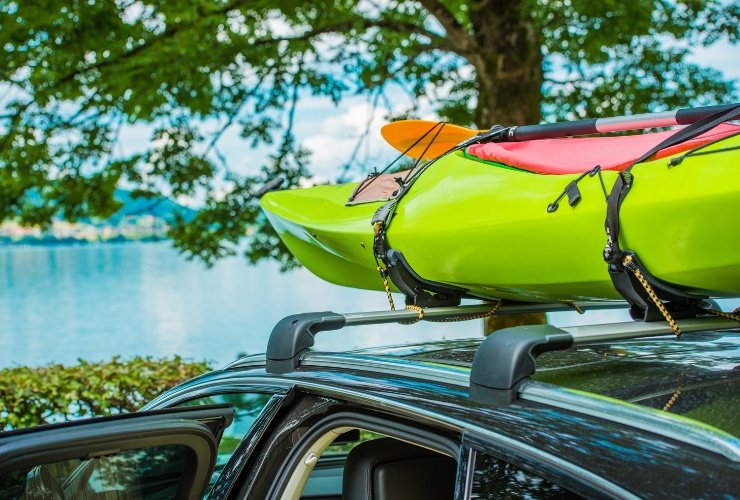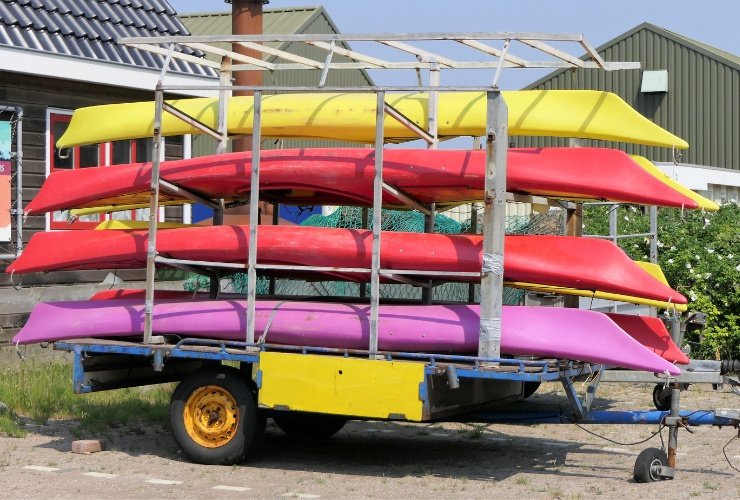Transporting your kayak on the correct side is vital to avoid damage and unnecessary wear and tear. While kayaks are made from sturdy materials, there are some things to understand that will help you answer the question: is it better to transport a kayak up or down?
There’s no quick answer to this question, as the materials your kayak is made from will determine how you can transport it. In order to gain a better understanding, and hopefully provide you with more insight about your own specific situation, let’s examine this in more detail.
Key Takeaways
- The best way to transport a kayak depends on the material it is made from–composite or polyethylene.
- Composite kayaks are more lightweight and performance-oriented, but also more prone to damage and warping. They should be transported upside down or on their side with a j cradle.
- Polyethylene kayaks are more durable and versatile and can be transported in any direction. You can also use foam blocks or any roof rack system.
- Transporting a kayak upside down has some advantages, such as protecting the cockpit from rain, reducing drag, and preventing hull deformation.
- Inflatable kayaks are the easiest to transport, as they can be deflated and placed inside a vehicle or secured to crossbars with minimal risk of puncture.
Before You Begin: What’s Your Kayak Made From?
Kayaks come in two main flavors: composite kayaks, or polyethylene (plastic-based) kayaks. The vast majority of recreational kayaks are plastic-based.
However, if you’re using any kayak constructed from materials that are designed to enhance the vessel’s performance in some way, there’s a good chance it’ll be made from composite materials (like fiberglass or carbon fiber).
Remember: your kayak’s materials determine how you can transport it. So, whether you transport it up or down depends on what it’s made from. If you’re unsure of the composition of your kayak, have a look at the owner’s manual.
Composite Kayaks Should Be Transported Upside Down
It’s greatly advised to transport any composite kayak upside down. Composite kayaks tend to be lightweight, handle better on the water, and favor performance over durability.
While these materials are hugely beneficial here, it makes the composite kayak more susceptible to cracks and warping from the tension placed on the hull by ratchet straps, ropes, and straps.
You can also use j cradles (which are a special type of roof rack system, sometimes referred to as a j rack). These allow the kayak to be safely transported on its side – resting on the hull.
The most important thing to remember is to avoid transporting a composite kayak with the cockpit facing up towards the sky – this will risk stress fractures across the hull from tie-downs.
Polyethylene (Plastic) Kayaks Can Be Transported in Any Way

A Polyethylene kayak is made from a high-density plastic that can take the strain of any transportation method.
You can use roof racks, and foam pads, you can secure these types of kayaks’ hull side down without risk of damage. You can also use a kayak trailer to transport one or multiple kayaks made from plastic.
If you have a sit-inside kayak, don’t forget to take any items out of the cockpit and use a sheet to cover the top of the kayak.
If you’re transporting multiple kayaks made from plastic then a j rack can also help you here, as you can lay the kayaks on their side.
Differences Between Transporting a Kayak up or Down
Transporting a kayak up or down refers to the direction the cockpit is facing – so transporting a kayak down means upside down and up means the cockpit is pointing up towards the sky.
Transporting a Kayak Cockpit Up
Transporting a kayak cockpit up is easier and as you’re most likely going to be transporting a polyethylene kayak. This way you don’t have to be concerned about tension cracking the hull – which means that practically any roof rack will work.
You can more easily put your kayak in the back of a vehicle (provided it’s large enough and the kayak isn’t too big) or on a trailer, and use tie-downs to secure it.
Generally speaking, it’s much easier to find roof racks for your vehicle when transporting a kayak this way. You also have the option to use foam blocks to make a DIY roof rack.
Transporting a Kayak Upside Down
Transporting a kayak upside down also gives you a few options – you can use crossbars and a roof rack system catered to composite kayaks, like a j cradle. It’s important that these fit your kayak properly – too tight and your kayak may suffer damage, but too loose and your kayak isn’t secure enough.
You might want to use crossbar pads to protect your kayak further if you opt to use this method.
If you use a j cradle then be careful that your kayak isn’t squashed from the bow to the stern – this is referred to as checking the bow and stern lines. If your kayak is laying on its side and squashed into a j cradle it can potentially deform the hull.
J cradles are a good option if you need to carry multiple kayaks.

Advantages of Transporting a Kayak Upside Down
Having an upside-down kayak while you’re on the road has a few plus sides to it:
- It protects your cockpit from the elements, especially rain.
- It’s essentially ‘easier’ to transport a kayak upside down because of the reduced drag on your vehicle.
- There’s almost zero risk of the hull deforming when a kayak is upside down.
- If you have a polyethylene kayak then you can use practically any method of transportation you want.
Disadvantages of Transporting a Kayak Upside Down
There are also some negatives:
- Transporting a kayak upside down involves the use of crossbars and more specialized roof racks.
- While some cars have these features built-in, many don’t.
- You have to make sure that roof rack, j cradle, foam blocks, or whatever you’re using fit your kayak really well. Too tight and it can cause damage, too loose and your kayak isn’t secure.
- It’s harder to transport multiple kayaks unless you have a larger vehicle.
Transporting an Inflatable Kayak
One of the best things about inflatable kayaks is that there’s much less to consider when transporting them.
Inflatable kayaks can be transported on their sides, facing up, or facing down, and they can even be deflated and placed inside a vehicle.
Most experienced kayakers will tell you to bring an air pump, deflate your kayak and simply put it in the trunk of your car. There’s less drag on your car if you don’t have a kayak on the roof, but it’s also fairly easy to secure an inflatable kayak to crossbars.
The most important thing is not to use tie-downs that risk puncturing the kayak.

Conclusion
Once you know what material your kayaks are made from you’ll know what the best method is for transporting kayaks. Polyethylene kayaks generally have more options for transportation because they’re a little bit more durable than composite-based kayaks.
Hopefully, the information here has helped you determine what’s the best transportation method for your kayak. Please comment if you have your own insights or share this with anyone else who might find this article useful.

